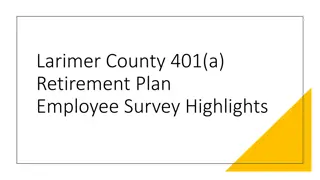Employee Participation Trends and Challenges in the UK
This presentation delves into the significance of employee participation and involvement (EPI) in the UK, discussing its operation, trends, challenges in precarious labor markets and the gig economy. It highlights the benefits of involving employees in decision-making processes, such as protecting workers' rights, promoting democratic and ethical values, and driving new ideas and ownership. The challenges for employee participation are explored within the economic, political, and social contexts of different countries. Various methods of exerting influence, including different levels of participation from disclosure of information to workers' control, are outlined. Moreover, the concept of indirect or representative participation is explained, detailing how decision-making is shared between management and workers through representatives, such as trade unions, staff associations, and legislation.
Download Presentation

Please find below an Image/Link to download the presentation.
The content on the website is provided AS IS for your information and personal use only. It may not be sold, licensed, or shared on other websites without obtaining consent from the author. Download presentation by click this link. If you encounter any issues during the download, it is possible that the publisher has removed the file from their server.
E N D
Presentation Transcript
Employee Participation in the UK: Current Trends and Practice NATIONAL SEMINAR Direct Participation European Experience and Implementation in Bulgaria Sofia, Globe Congress Center 31 March 2022 Prof. Michael Gold, RHUL 1
What this presentation covers Why employee participation and involvement (EPI)? How EPI operates Trends of EPI in the UK Challenges to EPI in precarious labour markets EPI in the gig economy 2
Why should firms involve their employees in decision-making process? Protection and extension of workers rights democratic and ethical values (the humanisation of the workplace) Economic reasons new ideas, sense of ownership towards decisions, higher level of effort, reduced labour costs (business case) Behavioural reasons lower cost and risk of disruption due to employee resistance (business case) (Gold 2010; Summers and Hyman 2005; Verma 1995) 3
Challenges for employee participation Forms of employee participation representational or direct are structured by the economic, political and social contexts of the countries in which they are located. These contexts include: changing nature of national labour markets (manufacturing and service sectors) influence of trade unions degree of flexible working patterns of migration 4
Methods of exerting influence Continuum of participation according to degree of worker influence: No participation Disclosure of information (communications) Consultation Negotiation Co-determination Workers control (e.g. workers co-operatives) (Blyton and Turnbull, 2004) 5
Indirect or representative participation Redistributive shares decision-making between management and workers: Participation through representatives (e.g. trade unions, staff associations etc.) Often supported by legislation, but also often negotiated between management and workers Goal is to protect workers collective interests Varying levels, stages, areas or topics covered 6
Forms of representative or indirect participation Works councils Joint consultation committees (JCCs) Health and safety committees Employee board-level participation (worker directors (Collective bargaining) Representation may or may not involve trade unions EU legislation covers: European works councils (1994) European Company Statute (2001) Information and consultation of employees (2002) 7
Direct forms of participation (sometimes called employee involvement ) Integrative ties individual to the firm: Management initiated practices Goal is to engage employees with the organisation s objectives and performance Individualistic and direct Options include financial participation 8
Forms of direct participation Workplace meetings, team briefings Newsletters Staff surveys Suggestion schemes Problem-solving groups, quality circles Team work Task-based involvement Financial participation Often linked to company culture and attitudinal change 9
Trends in EPI in the UK The following slides reveal: - decline in joint consultation, but holding up in public sector; - marked increase in direct participation (means of engaging employees at individual level); - slow but growing employee satisfaction with these means; - challenges posed by flexible (or precarious ) work patterns 10
Joint consultative committees (JCCs) (van Wanrooy et al. 2011: 15) No JCC (%) Workplace JCC (%) Higher level JCC only (%) Private manufacturing 2004 87 10 3 2011 90 6 4 Private services 2004 67 5 28 2011 80 6 15 Public sector 2004 28 19 53 2011 37 15 48 All 2004 64 7 28 2011 76 7 18 11
Direct participation (van Wanrooy et al. 2011: 18) Method 2004 (%) 2011 (%) All staff workplace meetings 75 80 Team briefings 60 66 Information on workplace finances 55 61 Staff surveys 36 37 Problem solving groups 17 14 12
Employees rating of management consultation (van Wanrooy et al. 2011: 18) Form of consultation Year Very good/good (%) Neither (%) Very poor/poor (%) Seeking views of employees 2004 48 26 26 2011 52 24 24 Responding to employee suggestions 2004 43 30 27 2011 46 28 26 Allowing emps. to influence decisions 2004 32 34 35 2011 34 34 31 13
Practices that reduce or avoid workplace disputes and promote good relations with employees (ACAS, 2020) 14
Recent labour market trends in UK Recent trends in UK labour markets seriously challenge all traditional forms of employee participation: declining influence of trade unions increasing significance of service sectors (now 83% employment; role of the customer) patterns of migration degree of flexible working, especially gig economy and zero-hours contracts 15
Standard and non-standard forms of employment 16
Core and peripheral model of organisational labour markets (Atkinson 1984, 1987) 17
How to involve peripheral and external workers in forms of participation? Example: gig economy CEO of CrowdFlower, one of the largest employment platforms, said that before the Internet, it would be really difficult to find someone, sit them down for ten minutes and get them to work for you, and then fire them after those ten minutes; but with technology, you can actually find them, pay them the tiny amount of money, and then get rid of them when you do not need them anymore. 18
Nature of gig work Algorithmic management undermines workers voice, but also resistance and possible representation. Even if forms of workers voice or unions exist, they cannot collectively bargain with an algorithm, they can t appeal to a platform, and they can t negotiate with an equation. In the gig economy, we can distinguish between: riders and drivers (who work on location-dependent labour platforms, such as Deliveroo and Uber) and freelance platform workers (increasingly outsourced external groups , who work remotely for online sites, that might be in homes or internet cafes). Riders and drivers can physically meet and virtually cooperate. Freelance platform workers are geographically dispersed and can cooperate only online. Yet despite the fragmentation, communication via social networks seems to create a degree of social connectedness among the participants, e.g. internet forums 90% of workers communication is organised through such forums. There are numerous websites and threads in which different groups of workers exchange information on different topics (Heiland, 2020: 28). 19
Low-paid and gig workers form unions The Independent Workers Union of Great Britain (2012): low-paid migrant workers who organise in IWGB branches covering cleaners, couriers, security guards and yoga teachers. It has fought campaigns for the London living wage at the Royal Opera House and John Lewis, among others. IWGB Game Workers (2018) was established as a branch of the umbrella IWGB. Aims include ending the institutionalised practice of excessive/unpaid overtime, improving diversity and inclusion, supporting those who lack representation and securing a fair wage for all. The App Drivers & Couriers Union (2020) campaigns for couriers and fast-food delivery drivers, including pay rises, employment status and an end to unfair dismissals and deactivations (that is, the deletion of a worker s details from an app for failing to meet targets). Source: union websites 20
Union organisation among gig workers Uber can revoke a driver s registration if his/her score falls below a certain level of passenger satisfaction, which is monitored electronically. In July 2020, the App Drivers and Couriers Union launched a legal bid to force the company to disclose the data on which it bases the algorithms that control their employment. ADCU argues that transparency is required to ensure that Uber does not discriminate between drivers. Spanish chambermaids have organised their own union, Sindicato Las Kellys Catalu a, which has set up its own reservations platform to monitor hotels compliance with the national agreement on pay and conditions. Tourists are able to book a hotel through an app that lists only those guaranteeing decent pay and conditions. In February 2021, the UK Supreme Court ruled unanimously that Uber drivers are employees under the terms of the Employment Rights Act 1996, and accordingly entitled to receive the national minimum wage, annual leave and other basic rights that apply to workers. Similar cases for employment status are under way at Addison Lee, City Sprint, Deliveroo, Excel and Hermes, among other platform-based companies. 21
Conclusions Traditional forms of EPI take place in bureaucratic/ hierarchical organisations, and work best for workers on standard employment contracts. Forms of representative EPI are in decline in UK, though direct forms seem healthy. But main challenge: how do unions organise/ ensure EPI for workers on precarious contracts, e.g. gig workers? 22
References ACAS (2020) Disputes and their Management in the Workplace: A Survey of British Employers. (Deborah Hann and David Nash) 30 April. Available at: Disputes and their management in the workplace: a survey ofBritish employers | Acas. Atkinson, J. (1984) Manpower strategies for flexible organisations. Personnel Management, 16: 28-31. Atkinson, J. (1987) Flexibility or fragmentation? The United Kingdom labour market in the eighties. Labour and Society, 12: 87-105. ETUI (2012) The Gateway to Participation Issues in Europe. Available at: http://www.worker-participation.eu/ Gold, M. (2004) Worker Mobilization in the 1970s: Revisiting Work-ins, Co-operatives and Alternative Corporate Plans , Historical Studies in Industrial Relations, No.18, Autumn 2004, pp. 65-106. Gold, M. (2010) Employee participation in the EU: The long and winding road to legislation , Economic and Industrial Democracy, 31(4s): 9-23. Hall, M. and Purcell, J. (2012) Consultation at Work. Regulation and Practice, Oxford University Press. Heiland, H. (2020) Workers voice in platform labour: An Overview, WSI Studies 21, The Institute of Economic and Social Research (WSI), Hans B ckler Foundation. Kersley, B., Oxenbridge, S., Dix, G., Bewley, H., Bryson, A., Forth, J. and Alpin, C. (2006) Inside the Workplace: Findings from the 2004 Workplace Employment Relations Survey, London: Department of Trade and Industry. Summers, J. and Hyman, J. (2005) Employee Participation and Company Performance: A Review of the Literature, Work and Opportunity Series No.33, York: Joseph Rowntree Foundation. Van Wanrooy, B., Bewley, H., Bryson, A., Forth, J., Freeth, S., Stokes, L. and Wood, S. (2011) The 2011 Workplace Employment Relations Study: First Findings, London: Department of Business, Innovation and Skills. Available at: https://www.gov.uk/government/uploads/system/uploads/attachment_data/file/210103/13-1010-WERS-first-findings-report-third-edition-may- 2013.pdf Verma, A. (1995) Employee involvement in the workplace , in M. Gunderson and A. Ponak (eds) Research in Personnel and Human Resource Management, New Haven, CT: JAI Press. Waddington, J. (2011) European Works Councils. A Transnational Industrial Relations Institution in the Making, Abingdon: Routledge. 23























